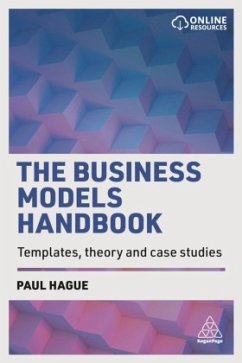- Broschiertes Buch
- Merkliste
- Auf die Merkliste
- Bewerten Bewerten
- Teilen
- Produkt teilen
- Produkterinnerung
- Produkterinnerung
Enhance your business and marketing planning and overcome common challenges, with this collection of the most valuable and reliable business frameworks and models.
Business frameworks sit at the heart of every successful business. They add structure and clarity to business problems and can help practitioners overcome the everyday challenges they face. The Business Models Handbook brings together the most helpful and widely used templates and frameworks into a single, invaluable resource. Each chapter focuses on an individual business framework, giving an overview of 50 of the best known…mehr
Andere Kunden interessierten sich auch für
![The Challenger Sale The Challenger Sale]() Matthew DixonThe Challenger Sale21,99 €
Matthew DixonThe Challenger Sale21,99 €![Participation Marketing Participation Marketing]() Michael BritoParticipation Marketing39,99 €
Michael BritoParticipation Marketing39,99 €![Confessions of the Pricing Man Confessions of the Pricing Man]() Hermann SimonConfessions of the Pricing Man34,34 €
Hermann SimonConfessions of the Pricing Man34,34 €![Product Innovation in the Global Fashion Industry Product Innovation in the Global Fashion Industry]() Product Innovation in the Global Fashion Industry49,99 €
Product Innovation in the Global Fashion Industry49,99 €![The New Marketing The New Marketing]() Cheryl BurgessThe New Marketing33,99 €
Cheryl BurgessThe New Marketing33,99 €![The New Marketing The New Marketing]() Cheryl BurgessThe New Marketing95,99 €
Cheryl BurgessThe New Marketing95,99 €![The Infinite Game The Infinite Game]() Simon SinekThe Infinite Game14,99 €
Simon SinekThe Infinite Game14,99 €-
-
-
Enhance your business and marketing planning and overcome common challenges, with this collection of the most valuable and reliable business frameworks and models.
Business frameworks sit at the heart of every successful business. They add structure and clarity to business problems and can help practitioners overcome the everyday challenges they face. The Business Models Handbook brings together the most helpful and widely used templates and frameworks into a single, invaluable resource. Each chapter focuses on an individual business framework, giving an overview of 50 of the best known frameworks and how it will help an organization grow and be profitable. Each supported by a real-world case study, these include ANSOFF matrix, Price-Quality-Strategy model, Stage-Gate model, Service Profit Chain and many more.
Authored by a leading global market researcher with a background working on over 3,000 different research projects, The Business Models Handbook is an invaluable resource for any student or professional. Online resources include lecture slides that align with each chapter.
Business frameworks sit at the heart of every successful business. They add structure and clarity to business problems and can help practitioners overcome the everyday challenges they face. The Business Models Handbook brings together the most helpful and widely used templates and frameworks into a single, invaluable resource. Each chapter focuses on an individual business framework, giving an overview of 50 of the best known frameworks and how it will help an organization grow and be profitable. Each supported by a real-world case study, these include ANSOFF matrix, Price-Quality-Strategy model, Stage-Gate model, Service Profit Chain and many more.
Authored by a leading global market researcher with a background working on over 3,000 different research projects, The Business Models Handbook is an invaluable resource for any student or professional. Online resources include lecture slides that align with each chapter.
Produktdetails
- Produktdetails
- Verlag: Kogan Page
- Artikelnr. des Verlages: 8180
- Seitenzahl: 336
- Erscheinungstermin: 7. März 2018
- Englisch
- Abmessung: 234mm x 156mm x 17mm
- Gewicht: 507g
- ISBN-13: 9780749481872
- ISBN-10: 0749481870
- Artikelnr.: 48209642
- Herstellerkennzeichnung Die Herstellerinformationen sind derzeit nicht verfügbar.
- Verlag: Kogan Page
- Artikelnr. des Verlages: 8180
- Seitenzahl: 336
- Erscheinungstermin: 7. März 2018
- Englisch
- Abmessung: 234mm x 156mm x 17mm
- Gewicht: 507g
- ISBN-13: 9780749481872
- ISBN-10: 0749481870
- Artikelnr.: 48209642
- Herstellerkennzeichnung Die Herstellerinformationen sind derzeit nicht verfügbar.
Paul Hague, based in Manchester, UK, is co- founder of B2B International. With 45 years of experience running market research agencies, his clients include Samsung, Microsoft, Henkel and Michelin. He has over 35 years of practical experience in running a successful market research agency and is the author of Market Research in Practice 5e and The Business Model Handbook, also published by Kogan Page.
- Chapter - 01: Introduction - An overview of business and marketing models;
- Chapter - 02: The 4Ps - How to design your marketing mix;
- Chapter - 03: ADL matrix - Strengthening a product portfolio or strategic business units;
- Chapter - 04: AIDA - A business model for improving marketing communications;
- Chapter - 05: Ansoff matrix - How to grow your company;
- Chapter - 06: Benchmarking - Setting targets for business and marketing KPIs;
- Chapter - 07: Blue ocean strategy - Kick-starting innovation and new product development;
- Chapter - 08: Boston Consulting Group (BCG) matrix - Planning a product portfolio or multiple strategic business units;
- Chapter - 09: Brand audit - Improving the strength of a brand;
- Chapter - 10: Competitive intelligence - Assessing market strengths and weaknesses;
- Chapter - 11: Conjoint analysis - Assessing optimum pricing and the value of component parts;
- Chapter - 12: Customer journey maps - Assessing the current performance of marketing and sales processes;
- Chapter - 13: Customer lifetime value - Estimating customer spend over their lifetime with the company;
- Chapter - 14: Customer value proposition - Creating a compelling purchase motive;
- Chapter - 15: Diffusion of innovation - Launching new products and services;
- Chapter - 16: Directional policy matrix - How to prioritize segments or new ideas;
- Chapter - 17: Disruptive innovation model - Identifying unique ways of beating the competition;
- Chapter - 18: Edward de Bono's six thinking hats - Brainstorming problems and generating new ideas;
- Chapter - 19: EFQM excellence model - Improving an organization's quality and performance;
- Chapter - 20: Four corners - Analysing competitor strategies;
- Chapter - 21: Gap analysis - Improving areas of weakness in a company;
- Chapter - 22: Greiner's growth model - Recognition and transition through different phases of company growth;
- Chapter - 23: Kano model - Identifying purchase motivations;
- Chapter - 24: Kotler's five product levels - Adding value to a product or service;
- Chapter - 25: Market sizing - Assessing the size and value of a served or potential market;
- Chapter - 26: Maslow's hierarchy - Differentiating market positioning;
- Chapter - 27: McKinsey 7S - A company 'health check' audit tool;
- Chapter - 28: Mintzberg's 5Ps for strategy - Devising a competitive strategy;
- Chapter - 29: MOSAIC - Setting objectives for current and potential opportunities and how to reach them;
- Chapter - 30: Net Promoter Score® - A tool for driving customer excellence;
- Chapter - 31: New product pricing (Gabor-Granger and van Westendorp) - Pricing new products;
- Chapter - 32: Personas - Improving the focus of marketing messages;
- Chapter - 33: PEST - Assessing four major macro factors that shape a company's future;
- Chapter - 34: Porter's five forces - Assessing five economic factors for competitive intensity;
- Chapter - 35: Porter's generic strategies - Pinpointing the strongest competitive position;
- Chapter - 36: Price elasticity - Outlining opportunities for raising or lowering prices;
- Chapter - 37: Price quality strategy - Guiding a company's pricing strategy;
- Chapter - 38: Product life cycle - Det
Chapter
01: Introduction
An overview of business and marketing models; Chapter
02: 3C framework
Maximizing a company's strength relative to the competition; Chapter
03: The 4Ps
How to design your marketing mix; Chapter
04: ADL matrix
Strengthening a product portfolio or strategic business units; Chapter
05: AIDA
A business model for improving marketing communications; Chapter
06: Ansoff matrix
How to grow your company; Chapter
07: Balanced scorecard
Measures and targets for achieving a strategy or improving performance; Chapter
08: Benchmarking
Setting targets for business and marketing KPIs; Chapter
09: Blue ocean strategy
Kick
starting innovation and new product development; Chapter
10: Boston Consulting Group (BCG) matrix
Planning a product portfolio or multiple strategic business units; Chapter
11: Brand audit
Improving the strength of a brand; Chapter
12: Bullseye for brand positioning
Finding the core values of a brand; Chapter
13: Business model canvas
Looking at key building blocks to see where improvements can be made; Chapter
14: Competitive advantage matrix
Working out requirements to obtain a competitive advantage; Chapter
15: Competitive intelligence
Assessing market strengths and weaknesses; Chapter
16: Conjoint analysis
Assessing optimum pricing and the value of component parts; Chapter
17: Customer activity cycle
Determining opportunities to lock in customers and give them more value; Chapter
18: Customer journey maps
Assessing the current performance of marketing and sales processes; Chapter
19: Customer lifetime value
Estimating customer spend over their lifetime with the company; Chapter
20: Customer value proposition
Creating a compelling purchase motive; Chapter
21: Diffusion of innovation
Launching new products and services; Chapter
22: Directional policy matrix
How to prioritize segments or new ideas; Chapter
23: Disruptive innovation model
Identifying unique ways of beating the competition; Chapter
24: Edward de Bono's six thinking hats
Brainstorming problems and generating new ideas; Chapter
25: EFQM excellence model
Improving an organization's quality and performance; Chapter
26: Four corners
Analysing competitor strategies; Chapter
27: Gap analysis
Improving areas of weakness in a company; Chapter
28: Greiner's growth model
Recognition and transition through different phases of company growth; Chapter
29: Importance
performance matrix
Improving the effectiveness of any business initiative; Chapter
30: Kano model
Identifying purchase motivations; Chapter
31: Kay's distinctive capabilities
Adding value by identifying your distinctive capabilities; Chapter
32: Kotler's five product levels
Adding value to a product or service; Chapter
33: Market sizing
Assessing the size and value of a served or potential market; Chapter
34: Maslow's hierarchy
Differentiating market positioning; Chapter
35: McKinsey 7S
A company 'health check' audit tool; Chapter
36: Mintzberg's 5Ps for strategy
Devising a competitive strategy; Chapter
37: MOSAIC
Setting objectives for current and potential opportunities and how to reach them; Chapter
38: Net Promoter Score®
A tool for driving customer excellence; Chapter
39: New product pricing (Gabor
Granger and van Westendorp)
Pricing new products; Chapter
40: Personas
Improving the focus of marketing messages; Chapter
41: PEST
Assessing four major macro factors that shape a company's future; Chapter
42: Porter's five forces
Assessing five economic factors for competitive intensity; Chapter
43: Porter's generic strategies
Pinpointing the strongest competitive position; Chapter
44: Price elasticity
Outlining opportunities for raising or lowering prices; Chapter
45: Price quality strategy
Guiding a company's pricing strategy; Chapter
46: Product life cycle
Determining a long
term product strategy; Chapter
47: Product service positioning matrix
Positioning products according to quality and service value; Chapter
48: Segmentation
Using customer groups to gain competitive advantage; Chapter
49: Service profit chain
Connecting employee satisfaction and performance with company profits; Chapter
50: SERVQUAL
Aligning customer expectations and company performance; Chapter
51: SIMALTO
Identifying the customer value placed on product or service improvements; Chapter
52: Stage gate new product development
Planning the development and launch of new products and services; Chapter
53: Strategy diamond
Entering new markets; Chapter
54: SWOT analysis
Analysing growth opportunities at product, team or business level; Chapter
55: System 1 and System 2 thinking
Identifying the emotional forces that drive decisions; Chapter
56: Tipping point
How small changes to behaviour can result in big achievements; Chapter
57: USP
Pinpointing the unique selling point of a product or service; Chapter
58: Value chain
Identifying product or service value during the manufacturing process; Chapter
59: Value equivalence line
Managing price and product benefits in a business strategy; Chapter
60: Value net
How to benefit from competitor collaboration; Chapter
61: Value
based marketing
Adding value to products and services to improve profitability; Chapter
62: VMOST
Defining strategies and preparing a business plan; Chapter
63: Weisbord's six box model
Assessing the efficient functioning of an organization;
01: Introduction
An overview of business and marketing models; Chapter
02: 3C framework
Maximizing a company's strength relative to the competition; Chapter
03: The 4Ps
How to design your marketing mix; Chapter
04: ADL matrix
Strengthening a product portfolio or strategic business units; Chapter
05: AIDA
A business model for improving marketing communications; Chapter
06: Ansoff matrix
How to grow your company; Chapter
07: Balanced scorecard
Measures and targets for achieving a strategy or improving performance; Chapter
08: Benchmarking
Setting targets for business and marketing KPIs; Chapter
09: Blue ocean strategy
Kick
starting innovation and new product development; Chapter
10: Boston Consulting Group (BCG) matrix
Planning a product portfolio or multiple strategic business units; Chapter
11: Brand audit
Improving the strength of a brand; Chapter
12: Bullseye for brand positioning
Finding the core values of a brand; Chapter
13: Business model canvas
Looking at key building blocks to see where improvements can be made; Chapter
14: Competitive advantage matrix
Working out requirements to obtain a competitive advantage; Chapter
15: Competitive intelligence
Assessing market strengths and weaknesses; Chapter
16: Conjoint analysis
Assessing optimum pricing and the value of component parts; Chapter
17: Customer activity cycle
Determining opportunities to lock in customers and give them more value; Chapter
18: Customer journey maps
Assessing the current performance of marketing and sales processes; Chapter
19: Customer lifetime value
Estimating customer spend over their lifetime with the company; Chapter
20: Customer value proposition
Creating a compelling purchase motive; Chapter
21: Diffusion of innovation
Launching new products and services; Chapter
22: Directional policy matrix
How to prioritize segments or new ideas; Chapter
23: Disruptive innovation model
Identifying unique ways of beating the competition; Chapter
24: Edward de Bono's six thinking hats
Brainstorming problems and generating new ideas; Chapter
25: EFQM excellence model
Improving an organization's quality and performance; Chapter
26: Four corners
Analysing competitor strategies; Chapter
27: Gap analysis
Improving areas of weakness in a company; Chapter
28: Greiner's growth model
Recognition and transition through different phases of company growth; Chapter
29: Importance
performance matrix
Improving the effectiveness of any business initiative; Chapter
30: Kano model
Identifying purchase motivations; Chapter
31: Kay's distinctive capabilities
Adding value by identifying your distinctive capabilities; Chapter
32: Kotler's five product levels
Adding value to a product or service; Chapter
33: Market sizing
Assessing the size and value of a served or potential market; Chapter
34: Maslow's hierarchy
Differentiating market positioning; Chapter
35: McKinsey 7S
A company 'health check' audit tool; Chapter
36: Mintzberg's 5Ps for strategy
Devising a competitive strategy; Chapter
37: MOSAIC
Setting objectives for current and potential opportunities and how to reach them; Chapter
38: Net Promoter Score®
A tool for driving customer excellence; Chapter
39: New product pricing (Gabor
Granger and van Westendorp)
Pricing new products; Chapter
40: Personas
Improving the focus of marketing messages; Chapter
41: PEST
Assessing four major macro factors that shape a company's future; Chapter
42: Porter's five forces
Assessing five economic factors for competitive intensity; Chapter
43: Porter's generic strategies
Pinpointing the strongest competitive position; Chapter
44: Price elasticity
Outlining opportunities for raising or lowering prices; Chapter
45: Price quality strategy
Guiding a company's pricing strategy; Chapter
46: Product life cycle
Determining a long
term product strategy; Chapter
47: Product service positioning matrix
Positioning products according to quality and service value; Chapter
48: Segmentation
Using customer groups to gain competitive advantage; Chapter
49: Service profit chain
Connecting employee satisfaction and performance with company profits; Chapter
50: SERVQUAL
Aligning customer expectations and company performance; Chapter
51: SIMALTO
Identifying the customer value placed on product or service improvements; Chapter
52: Stage gate new product development
Planning the development and launch of new products and services; Chapter
53: Strategy diamond
Entering new markets; Chapter
54: SWOT analysis
Analysing growth opportunities at product, team or business level; Chapter
55: System 1 and System 2 thinking
Identifying the emotional forces that drive decisions; Chapter
56: Tipping point
How small changes to behaviour can result in big achievements; Chapter
57: USP
Pinpointing the unique selling point of a product or service; Chapter
58: Value chain
Identifying product or service value during the manufacturing process; Chapter
59: Value equivalence line
Managing price and product benefits in a business strategy; Chapter
60: Value net
How to benefit from competitor collaboration; Chapter
61: Value
based marketing
Adding value to products and services to improve profitability; Chapter
62: VMOST
Defining strategies and preparing a business plan; Chapter
63: Weisbord's six box model
Assessing the efficient functioning of an organization;
- Chapter - 01: Introduction - An overview of business and marketing models;
- Chapter - 02: The 4Ps - How to design your marketing mix;
- Chapter - 03: ADL matrix - Strengthening a product portfolio or strategic business units;
- Chapter - 04: AIDA - A business model for improving marketing communications;
- Chapter - 05: Ansoff matrix - How to grow your company;
- Chapter - 06: Benchmarking - Setting targets for business and marketing KPIs;
- Chapter - 07: Blue ocean strategy - Kick-starting innovation and new product development;
- Chapter - 08: Boston Consulting Group (BCG) matrix - Planning a product portfolio or multiple strategic business units;
- Chapter - 09: Brand audit - Improving the strength of a brand;
- Chapter - 10: Competitive intelligence - Assessing market strengths and weaknesses;
- Chapter - 11: Conjoint analysis - Assessing optimum pricing and the value of component parts;
- Chapter - 12: Customer journey maps - Assessing the current performance of marketing and sales processes;
- Chapter - 13: Customer lifetime value - Estimating customer spend over their lifetime with the company;
- Chapter - 14: Customer value proposition - Creating a compelling purchase motive;
- Chapter - 15: Diffusion of innovation - Launching new products and services;
- Chapter - 16: Directional policy matrix - How to prioritize segments or new ideas;
- Chapter - 17: Disruptive innovation model - Identifying unique ways of beating the competition;
- Chapter - 18: Edward de Bono's six thinking hats - Brainstorming problems and generating new ideas;
- Chapter - 19: EFQM excellence model - Improving an organization's quality and performance;
- Chapter - 20: Four corners - Analysing competitor strategies;
- Chapter - 21: Gap analysis - Improving areas of weakness in a company;
- Chapter - 22: Greiner's growth model - Recognition and transition through different phases of company growth;
- Chapter - 23: Kano model - Identifying purchase motivations;
- Chapter - 24: Kotler's five product levels - Adding value to a product or service;
- Chapter - 25: Market sizing - Assessing the size and value of a served or potential market;
- Chapter - 26: Maslow's hierarchy - Differentiating market positioning;
- Chapter - 27: McKinsey 7S - A company 'health check' audit tool;
- Chapter - 28: Mintzberg's 5Ps for strategy - Devising a competitive strategy;
- Chapter - 29: MOSAIC - Setting objectives for current and potential opportunities and how to reach them;
- Chapter - 30: Net Promoter Score® - A tool for driving customer excellence;
- Chapter - 31: New product pricing (Gabor-Granger and van Westendorp) - Pricing new products;
- Chapter - 32: Personas - Improving the focus of marketing messages;
- Chapter - 33: PEST - Assessing four major macro factors that shape a company's future;
- Chapter - 34: Porter's five forces - Assessing five economic factors for competitive intensity;
- Chapter - 35: Porter's generic strategies - Pinpointing the strongest competitive position;
- Chapter - 36: Price elasticity - Outlining opportunities for raising or lowering prices;
- Chapter - 37: Price quality strategy - Guiding a company's pricing strategy;
- Chapter - 38: Product life cycle - Det
Chapter
01: Introduction
An overview of business and marketing models; Chapter
02: 3C framework
Maximizing a company's strength relative to the competition; Chapter
03: The 4Ps
How to design your marketing mix; Chapter
04: ADL matrix
Strengthening a product portfolio or strategic business units; Chapter
05: AIDA
A business model for improving marketing communications; Chapter
06: Ansoff matrix
How to grow your company; Chapter
07: Balanced scorecard
Measures and targets for achieving a strategy or improving performance; Chapter
08: Benchmarking
Setting targets for business and marketing KPIs; Chapter
09: Blue ocean strategy
Kick
starting innovation and new product development; Chapter
10: Boston Consulting Group (BCG) matrix
Planning a product portfolio or multiple strategic business units; Chapter
11: Brand audit
Improving the strength of a brand; Chapter
12: Bullseye for brand positioning
Finding the core values of a brand; Chapter
13: Business model canvas
Looking at key building blocks to see where improvements can be made; Chapter
14: Competitive advantage matrix
Working out requirements to obtain a competitive advantage; Chapter
15: Competitive intelligence
Assessing market strengths and weaknesses; Chapter
16: Conjoint analysis
Assessing optimum pricing and the value of component parts; Chapter
17: Customer activity cycle
Determining opportunities to lock in customers and give them more value; Chapter
18: Customer journey maps
Assessing the current performance of marketing and sales processes; Chapter
19: Customer lifetime value
Estimating customer spend over their lifetime with the company; Chapter
20: Customer value proposition
Creating a compelling purchase motive; Chapter
21: Diffusion of innovation
Launching new products and services; Chapter
22: Directional policy matrix
How to prioritize segments or new ideas; Chapter
23: Disruptive innovation model
Identifying unique ways of beating the competition; Chapter
24: Edward de Bono's six thinking hats
Brainstorming problems and generating new ideas; Chapter
25: EFQM excellence model
Improving an organization's quality and performance; Chapter
26: Four corners
Analysing competitor strategies; Chapter
27: Gap analysis
Improving areas of weakness in a company; Chapter
28: Greiner's growth model
Recognition and transition through different phases of company growth; Chapter
29: Importance
performance matrix
Improving the effectiveness of any business initiative; Chapter
30: Kano model
Identifying purchase motivations; Chapter
31: Kay's distinctive capabilities
Adding value by identifying your distinctive capabilities; Chapter
32: Kotler's five product levels
Adding value to a product or service; Chapter
33: Market sizing
Assessing the size and value of a served or potential market; Chapter
34: Maslow's hierarchy
Differentiating market positioning; Chapter
35: McKinsey 7S
A company 'health check' audit tool; Chapter
36: Mintzberg's 5Ps for strategy
Devising a competitive strategy; Chapter
37: MOSAIC
Setting objectives for current and potential opportunities and how to reach them; Chapter
38: Net Promoter Score®
A tool for driving customer excellence; Chapter
39: New product pricing (Gabor
Granger and van Westendorp)
Pricing new products; Chapter
40: Personas
Improving the focus of marketing messages; Chapter
41: PEST
Assessing four major macro factors that shape a company's future; Chapter
42: Porter's five forces
Assessing five economic factors for competitive intensity; Chapter
43: Porter's generic strategies
Pinpointing the strongest competitive position; Chapter
44: Price elasticity
Outlining opportunities for raising or lowering prices; Chapter
45: Price quality strategy
Guiding a company's pricing strategy; Chapter
46: Product life cycle
Determining a long
term product strategy; Chapter
47: Product service positioning matrix
Positioning products according to quality and service value; Chapter
48: Segmentation
Using customer groups to gain competitive advantage; Chapter
49: Service profit chain
Connecting employee satisfaction and performance with company profits; Chapter
50: SERVQUAL
Aligning customer expectations and company performance; Chapter
51: SIMALTO
Identifying the customer value placed on product or service improvements; Chapter
52: Stage gate new product development
Planning the development and launch of new products and services; Chapter
53: Strategy diamond
Entering new markets; Chapter
54: SWOT analysis
Analysing growth opportunities at product, team or business level; Chapter
55: System 1 and System 2 thinking
Identifying the emotional forces that drive decisions; Chapter
56: Tipping point
How small changes to behaviour can result in big achievements; Chapter
57: USP
Pinpointing the unique selling point of a product or service; Chapter
58: Value chain
Identifying product or service value during the manufacturing process; Chapter
59: Value equivalence line
Managing price and product benefits in a business strategy; Chapter
60: Value net
How to benefit from competitor collaboration; Chapter
61: Value
based marketing
Adding value to products and services to improve profitability; Chapter
62: VMOST
Defining strategies and preparing a business plan; Chapter
63: Weisbord's six box model
Assessing the efficient functioning of an organization;
01: Introduction
An overview of business and marketing models; Chapter
02: 3C framework
Maximizing a company's strength relative to the competition; Chapter
03: The 4Ps
How to design your marketing mix; Chapter
04: ADL matrix
Strengthening a product portfolio or strategic business units; Chapter
05: AIDA
A business model for improving marketing communications; Chapter
06: Ansoff matrix
How to grow your company; Chapter
07: Balanced scorecard
Measures and targets for achieving a strategy or improving performance; Chapter
08: Benchmarking
Setting targets for business and marketing KPIs; Chapter
09: Blue ocean strategy
Kick
starting innovation and new product development; Chapter
10: Boston Consulting Group (BCG) matrix
Planning a product portfolio or multiple strategic business units; Chapter
11: Brand audit
Improving the strength of a brand; Chapter
12: Bullseye for brand positioning
Finding the core values of a brand; Chapter
13: Business model canvas
Looking at key building blocks to see where improvements can be made; Chapter
14: Competitive advantage matrix
Working out requirements to obtain a competitive advantage; Chapter
15: Competitive intelligence
Assessing market strengths and weaknesses; Chapter
16: Conjoint analysis
Assessing optimum pricing and the value of component parts; Chapter
17: Customer activity cycle
Determining opportunities to lock in customers and give them more value; Chapter
18: Customer journey maps
Assessing the current performance of marketing and sales processes; Chapter
19: Customer lifetime value
Estimating customer spend over their lifetime with the company; Chapter
20: Customer value proposition
Creating a compelling purchase motive; Chapter
21: Diffusion of innovation
Launching new products and services; Chapter
22: Directional policy matrix
How to prioritize segments or new ideas; Chapter
23: Disruptive innovation model
Identifying unique ways of beating the competition; Chapter
24: Edward de Bono's six thinking hats
Brainstorming problems and generating new ideas; Chapter
25: EFQM excellence model
Improving an organization's quality and performance; Chapter
26: Four corners
Analysing competitor strategies; Chapter
27: Gap analysis
Improving areas of weakness in a company; Chapter
28: Greiner's growth model
Recognition and transition through different phases of company growth; Chapter
29: Importance
performance matrix
Improving the effectiveness of any business initiative; Chapter
30: Kano model
Identifying purchase motivations; Chapter
31: Kay's distinctive capabilities
Adding value by identifying your distinctive capabilities; Chapter
32: Kotler's five product levels
Adding value to a product or service; Chapter
33: Market sizing
Assessing the size and value of a served or potential market; Chapter
34: Maslow's hierarchy
Differentiating market positioning; Chapter
35: McKinsey 7S
A company 'health check' audit tool; Chapter
36: Mintzberg's 5Ps for strategy
Devising a competitive strategy; Chapter
37: MOSAIC
Setting objectives for current and potential opportunities and how to reach them; Chapter
38: Net Promoter Score®
A tool for driving customer excellence; Chapter
39: New product pricing (Gabor
Granger and van Westendorp)
Pricing new products; Chapter
40: Personas
Improving the focus of marketing messages; Chapter
41: PEST
Assessing four major macro factors that shape a company's future; Chapter
42: Porter's five forces
Assessing five economic factors for competitive intensity; Chapter
43: Porter's generic strategies
Pinpointing the strongest competitive position; Chapter
44: Price elasticity
Outlining opportunities for raising or lowering prices; Chapter
45: Price quality strategy
Guiding a company's pricing strategy; Chapter
46: Product life cycle
Determining a long
term product strategy; Chapter
47: Product service positioning matrix
Positioning products according to quality and service value; Chapter
48: Segmentation
Using customer groups to gain competitive advantage; Chapter
49: Service profit chain
Connecting employee satisfaction and performance with company profits; Chapter
50: SERVQUAL
Aligning customer expectations and company performance; Chapter
51: SIMALTO
Identifying the customer value placed on product or service improvements; Chapter
52: Stage gate new product development
Planning the development and launch of new products and services; Chapter
53: Strategy diamond
Entering new markets; Chapter
54: SWOT analysis
Analysing growth opportunities at product, team or business level; Chapter
55: System 1 and System 2 thinking
Identifying the emotional forces that drive decisions; Chapter
56: Tipping point
How small changes to behaviour can result in big achievements; Chapter
57: USP
Pinpointing the unique selling point of a product or service; Chapter
58: Value chain
Identifying product or service value during the manufacturing process; Chapter
59: Value equivalence line
Managing price and product benefits in a business strategy; Chapter
60: Value net
How to benefit from competitor collaboration; Chapter
61: Value
based marketing
Adding value to products and services to improve profitability; Chapter
62: VMOST
Defining strategies and preparing a business plan; Chapter
63: Weisbord's six box model
Assessing the efficient functioning of an organization;
"As strategy is all about three things - implementation, implementation, implementation - The Business Models Handbook is especially useful because it not only discusses the most important business models, but also provides practical guidance on how each model can be used." Rennie Gould, CEO, Customize UK Training








